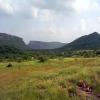| Explore India |
|
Ranthambore National Park Travel Guide
Ranthambore National Park Travel Guide
Ranthambore derives its name from two hills Ran and Thambor and is a perfect place for wildlife enthusiasts. Located at the Sawai Madhopur district of Rajasthan, Ranthambore is famous for its rich wildlife. It lies at the confluence of the Aravali and Vindhyachal ranges engulfed by thick deciduous forest and dhok trees. A ride through this National park will bring you in close contact with nature and various wild animals as prevalent in their natural habitat. The Ranthambore National is spread over an area of 500 sq km and was acknowledged as a wildlife sanctuary in the year 1955. In 1981 it was confirmed as a National Park.
The Ranthambore National Park is the abode and breeding ground for a large number of wild animals some of which are Tigers, Leopards, Chital, Nilgai, Common langurs, Macaques, Sambar deer, Striped Hyenas, Jackals, Caracals, Black bucks, Indian Wild Boar, Common Yellow Bats, Desert Cats, Common Palm Civets or Toddy Cat, Common mongoose, Rufoustailed Hare, Jungle Cats, Chinkara, Sloth Bears, Five Striped Palm Squirrels, Indian False Vampires, Indian Flying Foxes, Indian Porcupines etc. The park is also the habitat of a number of fascinating reptiles like Snub Nose Marsh Crocodiles, Desert Monitor Lizards, Common Kraits, Banded Kraits, Indian Pythons, Rat Snakes, Russel’s Vipers, Cobras etc. The wild species can be captured in all their moods and temperaments.
The setting of Ranthambore is amplified by the Rocky Mountains, lofty hills, immaculate lake and ponds and vast stretches of ravines. At Ranthambore one can envisage a perfect amalgamation of wildlife, history, nature and heritage. The charm of the place emanates at every new turn of the road. Meet the inhabitants of the park and you are sure to experience a thrilling adventure. Other places of attractions in and around Ranthambore are the Ranthambore Fort, Padam Talab, Kachida Valley, Raj Bagh Talab, Raj Bagh, Jogi Mahal, Lakarda and Anantpura and Malik Talab.
Built by the Chauhans in the 10th century the Ranthambore Fort is an old fort which has some interesting story associated with it. It was erected to keep enemies at bay. Jogi Mahal is also an interesting place to visit. It is a forest rest house located at the suburb of the National Park and is famous for possessing the second largest banyan tree in the country.
Ranthambore is well connected with all the major cities and hence can be easily accessed. The Ranthambore National Park being one of the major attractions at Ranthambore draws a considerable number of tourists every year. Nature and wildlife enthusiasts can gratify their thirst for knowledge in all spheres of flora and fauna at their very entrance to the Ranthambore National Park.
Last Updated: 29/03/2012
Sign In to Share your Experience


